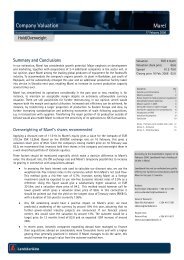Ársskýrsla Landsbankans - Landsbankinn
Ársskýrsla Landsbankans - Landsbankinn
Ársskýrsla Landsbankans - Landsbankinn
You also want an ePaper? Increase the reach of your titles
YUMPU automatically turns print PDFs into web optimized ePapers that Google loves.
Notes to the Consolidated Financial Statements<br />
53. Credit risk measurement<br />
The Group monitors exposures to identify signs of weakness in customer earnings and liquidity as soon as possible. On the basis of customer data,<br />
the Group has developed internally a number of statistical models to predict the probability of customers defaulting on their obligations to the<br />
Group, as defined in the internal rating based approach of the Basel II framework. Customers of the Group are assigned to a rating grade on the<br />
internal rating scale on the basis of the estimated probability of default. Work to validate and improve the Group’s internal rating system started in<br />
2010 and will continue in 2011, with the objective to ensure compliance with the internal rating based approaches, starting with the foundation<br />
approach.<br />
Supplemental to using ratings, the Group uses a second classification for customer groups with loan exposures above ISK 500 million. A simple<br />
means of classification was devised initially, creating three credit risk groups (green, amber and red), which were used from the foundation of the<br />
Bank in 2008 until 2010. Following changes in the structure of the Risk Management Division in 2010 and the implementation of a credit risk early<br />
warning system, the colour classification used in 2010 was the following:<br />
• Green customers are those that are considered performing without difficulties.<br />
• Yellow customers are those that are on Watch list 1, which have temporary difficulties and may need some installments postponed or modification<br />
to terms or loan covenants.<br />
• Orange customers are those that are on Watch list 2. They are still under the supervision of the relevant business unit but are likely to go through<br />
loan restucturing or installments postponed.<br />
• Red customers are those that are under the supervision of the Asset Restructuring division and need restructuring, write-offs or debt-to-equity<br />
conversion. The management of the customer‘s operations will possibly be taken over by the Group. In some cases, collateral or guarantees will be<br />
collected and/or the operations sold.<br />
Customer groups with loan exposure below ISK 500 million will be grouped into green, yellow, orange and red credit risk groups during the year<br />
2011.<br />
The following table presents the classification of loans and advances to customers by credit risk groups:<br />
Carrying amount<br />
Customer groups with loan exposures above ISK 500 million<br />
2010 2009<br />
Green 197,331 199,521<br />
Yellow 21,669 16,399<br />
Orange 23,982 20,008<br />
Red 51,867 113,711<br />
Customer groups with loan exposures below ISK 500 million 298,105 , 317,483 ,<br />
Total 592,954 667,122<br />
External ratings were used where applicable to assist in managing the credit risk exposure of bonds. Otherwise the Group used fair value estimates<br />
based on available information and the Group's own estimates.<br />
The Group measures the credit risk of derivatives by calculating a credit equivalent value for each derivative. The credit equivalent value is the<br />
market value of a contract plus a percentage of the nominal amount of the derivative which depends on the type of derivative. The percentage is<br />
twice that of the 99% Value at Risk (VaR), calculated for each underlying security or currency based on historical volatility, for a holding period of<br />
five days.<br />
54. Loan impairment<br />
Group policy requires that individual financial assets above materiality thresholds be reviewed at least quarterly, and more frequently when<br />
circumstances so demand. Impairment allowances on individually assessed accounts are determined case-by-case by evaluating incurred losses at<br />
the reporting date. Collectively assessed impairment allowances are permitted in the following cases: (i) portfolios of homogenous loans that are<br />
individually below materiality thresholds, and (ii) losses that have been incurred but not yet identified, using the available historical experience along<br />
with experienced judgement and statistical techniques.<br />
Should the expected cash flows be re-examined and the present value of the cash flows (calculated using the effective interest rate) be revised, the<br />
difference is then recognised in profit or loss (as either impairment or net adjustments to loans and advances). Impairment is calculated using the<br />
effective interest rate, before any revision of the expected cash flows. Any adjustments to the carrying amount which result from revising the<br />
expected cash flows are recognised in profit or loss. The impact of financial restructuring of the Group’s customers in 2010 is reflected in loan<br />
impairment, or net adjustments to loans and advances, as the expected cash flow of customers has changed.<br />
The Group measures and estimates the impact of foreign exchange rate changes on the financial strength of each borrower or group of borrowers.<br />
While some customers receive income partially or fully in foreign currency, other customers have very limited or no income in foreign currency.<br />
Customers with limited income in foreign currency will suffer more than others, should the ISK depreciate.<br />
NBI hf. Consolidated Financial Statements 2010 55<br />
All amounts are in ISK million<br />
Allar upphæðir eru í milljónum króna Ársreikningur 2010 155



